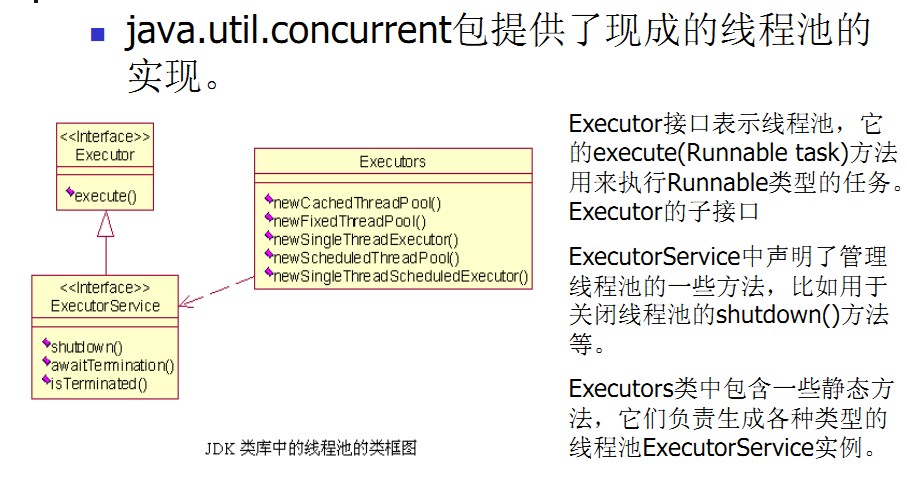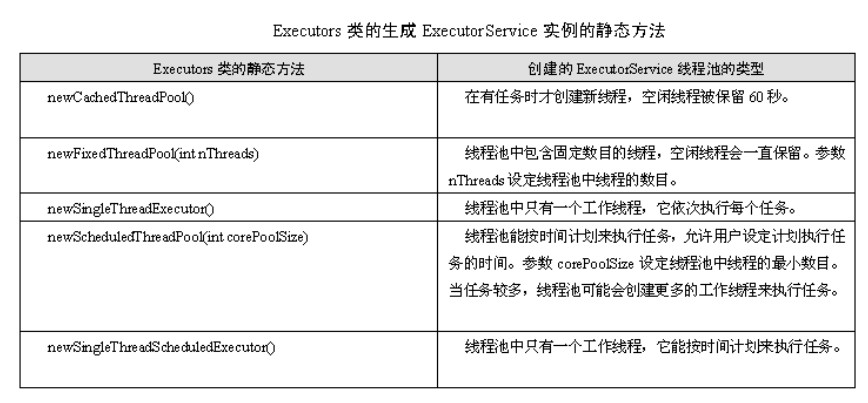java类库中提供的线程池简介:
java提供的线程池更加强大,相信理解线程池的工作原理,看类库中的线程池就不会感到陌生了。


- execute(Runnable command):履行Ruannable类型的任务
- submit(task):可用来提交Callable或Runnable任务,并返回代表此任务的Future对象
- invokeAll(collection of tasks):执行给定的任务,当所有任务完成时,返回保持任务状态和结果的 Future 列表.
- shutdown():在完成已提交的任务后封闭办事,不再接管新任务
- shutdownNow():停止所有正在履行的任务并封闭办事。
- isTerminated():测试是否所有任务都履行完毕了。
- isShutdown():测试是否该ExecutorService已被封闭
1、固定大小线程池
import java.util.concurrent.Executors; import java.util.concurrent.ExecutorService; ExecutorService pool = Executors.newFixedThreadPool(2); pool.execute(t1); pool.shutdown();
2、单任务线程池
ExecutorService pool = Executors.newSingleThreadExecutor();
3、可变尺寸线程池
ExecutorService pool = Executors.newCachedThreadPool();
4、延迟连接池
ScheduledExecutorService pool = Executors.newScheduledThreadPool(2); pool.schedule(t4, 10, TimeUnit.MILLISECONDS);
5、单任务延迟连接池
ScheduledExecutorService pool = Executors.newSingleThreadScheduledExecutor();
1.schedule
schedule(Runnable command, long delay, TimeUnit unit),schedule方法被用来延迟指定时间后执行某个指定任务。
a.Java代码如下:
import java.text.SimpleDateFormat;
import java.util.Date;
import java.util.concurrent.Executors;
import java.util.concurrent.ScheduledExecutorService;
import java.util.concurrent.TimeUnit;
//内部线程工作类
class Job implements Runnable {
SimpleDateFormat sdf = new SimpleDateFormat("yyyy-MM-dd hh:mm:ss");
public void run() {
try {
Thread.sleep(5000);
} catch (InterruptedException ex) {
ex.printStackTrace();
}
System.out.println("do something at:" + sdf.format(new Date()));
}
}
public class ScheduledExecutorServiceTest {
public static void main(String[] args) {
ScheduledExecutorService schedule = Executors.newScheduledThreadPool(5);
final SimpleDateFormat sdf = new SimpleDateFormat("yyyy-MM-dd hh:mm:ss");
System.out.println("begin to do something at:"+ sdf.format(new Date()));
schedule.schedule( new Job(), 1, TimeUnit.SECONDS);
}
}
b.输出如下:
begin to do something at:2015-04-27 10:29:56
do something at:2015-04-27 10:30:02
注:此时程序不会退出,若想让程序退出,需要加上schedule.shutdown();
ScheduledExecutorService 中两种最常用的调度方法 ScheduleAtFixedRate 和 ScheduleWithFixedDelay。
ScheduleAtFixedRate 每次执行时间为上一次任务开始起向后推一个时间间隔,即每次执行时间为 :initialDelay, initialDelay+period, initialDelay+2*period, …;
ScheduleWithFixedDelay 每次执行时间为上一次任务结束起向后推一个时间间隔,即每次执行时间为:initialDelay, initialDelay+executeTime+delay, initialDelay+2*executeTime+2*delay。
由此可见,ScheduleAtFixedRate 是基于固定时间间隔进行任务调度,ScheduleWithFixedDelay 取决于每次任务执行的时间长短,是基于不固定时间间隔进行任务调度。
2.scheduleWithFixedDelay
scheduleWithFixedDelay(Runnable command, long initialDelay, long delay,TimeUnit unit)
创建并执行一个在给定初始延迟后首次启用的定期操作,随后,在每一次执行终止和下一次执行开始之间都存在给定的延迟,如果任务的执行时间超过了廷迟时间(delay),下一个任务则会在当前任务执行所需时间+delay)后执行。
a.Java代码如下:
public class ScheduledExecutorServiceTest {
public static void main(String[] args) {
ScheduledExecutorService schedule = Executors.newScheduledThreadPool(5);
final SimpleDateFormat sdf = new SimpleDateFormat("yyyy-MM-dd hh:mm:ss");
System.out.println(" begin to do something at:"+ sdf.format(new Date()));
schedule.scheduleWithFixedDelay(new Job(), 1, 2, TimeUnit.SECONDS);
}
}
b.输出如下:
- begin to do something at:2012-08-03 09:36:53
- do something at:2012-08-03 09:36:59
- do something at:2012-08-03 09:37:06
- do something at:2012-08-03 09:37:13
3.scheduleAtFixedRate
scheduleAtFixedRate(Runnable command, long initialDelay, long period, TimeUnitunit)
创建并执行一个在给定初始延迟后首次启用的定期操作,后续操作具有给定的周期;也就是将在 initialDelay 后开始执行,然后在initialDelay+period 后执行,接着在 initialDelay + 2 * period 后执行,依此类推。如果任务的执行时间小于period,将会按上述规律执行。否则,则会按任务的实际执行时间进行周期执行。
a.代码如下:
public class ScheduledExecutorServiceTest {
public static void main(String[] args) {
ScheduledExecutorService schedule = Executors.newScheduledThreadPool(2);
final SimpleDateFormat sdf = new SimpleDateFormat("yyyy-MM-dd hh:mm:ss");
System.out.println(" begin to do something at:" + sdf.format(new Date()));
schedule.scheduleAtFixedRate(new Job(), 1,2, TimeUnit.SECONDS);
}
}
b.结果输出:
- begin to do something at:2012-08-04 08:53:30
- do something at:2012-08-04 08:53:36
- do something at:2012-08-04 08:53:41
- do something at:2012-08-04 08:53:46
- do something at:2012-08-04 08:53:51